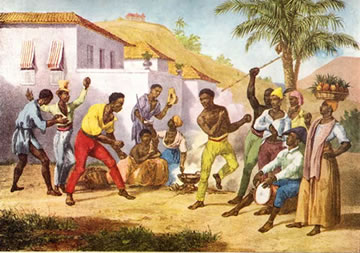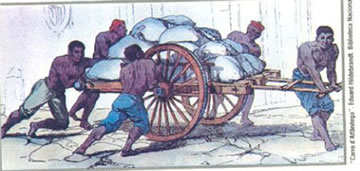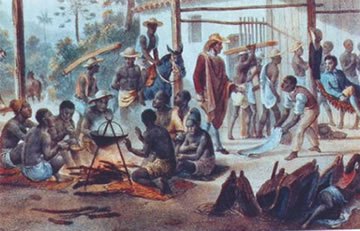ABOUT CAPOEIRA - History

:: In the beginning

Brazil's history, let alone Capoeira's, can be contradictory, peculiar and complex due to an influx of African, European and native cultures interacting in all aspects of life in Brazil. Thus creating a unique melting pot in which each culture tried to (and successfully did) preserve their identities in different regions, aspects and social levels throughout the country.
What we do know is that although Capoeira has no written history until the 18th century, it definitely existed. This is most obviously portrayed by the art's oral history and tradition. Most, if not all, of the songs your teacher or Mestre know is from hearing the song from their teacher, friend and family etc, and so this goes hand in hand with other knowledge of the art.
Capoeira has a huge oral tradition and this begins when the Portuguese first descended upon Africa to procure slaves through any means necessary. The Portuguese had already been to Brazil however. Seen as an excellent outpost for the Portuguese empire, it was close to Africa and India for convoys of trade. In 1500 they first set foot in Brazil and interacted and co-existed with the indigenous native tribes of Brazil, mainly the Tupi, and for 322 years Brazil was a Portuguese colony.
The Portuguese had massive plantations that they needed the natives to work on.
At first they purchased their slavery, exchanging all sorts of items but nothing of enough worth. Then they simply began forcing them to work with muskets and whips.
Eventually the Portuguese needed and wanted slaves from Africa, of which they already had hundreds of thousands in other parts of their empire for a century before they colonized Brazil. So it was a natural step for them to transport more captive Africans to Brazil. They came predominantly from Sudan, Guinea and Angola, though in those days borders were not so strict and there were slaves from Congo and Mozambique too. Tribes called Yoruba, Hausa and Bantu to name but a few. At first they enslaved only those whom they found got in their way, though it does not take long for power to corrupt and eventually slave trade was a business itself, human beings thought of as merchandise.

Initially the cost of this was "cheap" and being greedy they over crowded the vessels which transported the slaves to Brazil. Which, back in the 16th century this was not an easy task, with terrible conditions for the slaves during a three month journey; they lost approximately 400,000 lives, bodies thrown away in to the deep Atlantic sea. With a high mortality rate of slaves in Brazil there were approximately 4,000,000 (four million!!!) slaves traded until 1850, when the Queiroz law abolished slavery. Though it continued illegally until 1888/89!
The slaves were always mixed, held in different plantations and senzalas (slave quarters) to familiar people (friends and family especially) and so making organized rebellions difficult. Nevertheless, as well as constant individual escapes, there were recorded revolts against their captivity and many times when they escaped they formed independent 'slave' villages in the jungles, forests and 'backlands', which were called Quilombos.
This was integral to the birth of Capoeira
:: Early Brazil 1900s

The slaves were not allowed any luxuries, especially the practice of fighting. There are many theories as to the actual birth of Capoeira, and there is no definite, finite birth or date where suddenly someone said this is Capoeira.
In 1890, the first Brazilian president Marechal Deodoro da Fonseca created the Código Penal, which contained an act that prohibited the practice of Capoeira nationwide, with severe punishment for those caught. Regardless of this it remained, practiced by the poorer population on public holidays, during work-free hours and similar occasions. Riots caused by police interference were common. The nick-names in Capoeira were predominant from the early days of the art but became more popular once Capoeira was officially illegal. This is something we keep today as a tradition.
And so it was a bad time to be a Capoeirista.
Capoeira even before this was often attributed to sneaky, violent criminals who were low- lives, sons of slaves etc... Much of the time Capoeira was played in like a death game, sometimes with razor blades between their toes when they fought or a hidden knife in their trousers, inviting a trend of silk scarves around the necks of Capoeiristas at rodas everywhere.
And it wasn't just the razor blades, due to the quality of life and the association with Capoeira a lot of people were struggling just to survive day to day life, many carried knives and weapons which unfortunately came out in rodas too. Capoeira was never a popular art form (in fact it wasn't even known as one until the 30s/40s) and so when it became officially illegal many Capoeiristas turned to crime, of all sorts. Being self confident, with a fighting spirit and anger at the sudden 'freedom' many were given it was not a surprise that with nowhere to go and nothing to do they turned to crime.
It was also during this period that great Capoeiristas would rise up to fight off the persecution and repression of Capoeira. While the art had spread in this early period the police and government were cracking down so hard that it was all but extinguished in Rio and Recife. Recife had seen the Capoeira turn into a protection detail for the bands during Carnival and big events. A big band would march with a Capoeirista at the forefront and whenever another band was encountered there would be bloodshed. The Capoeira in Rio was simply more of a rogue/ criminal activity, in fact gangs had been formed that were so dangerous and powerful the government would use them to fend off rallies and unpopular group behaviour.
Brazil was forcing Capoeira into a corner; one which it did not want to be in and for a while did not know how to get out of.
:: 1900 - 1932
Capoeira does not go away. No matter what the police did, who they killed, beat, tortured or corrupted it was always there, underneath the eyes of the authorities and people who didn't know what to look for. This period in time would turn out to be one of the most important periods in the already long saga of Capoeira.
There were legendary figures like Besouro, who had Corpo Fechado (closed body - a supposed magic of invulnerability) and Nascimento Grande who fought police when they had to and always came out on top.
Only 3 years prior to the start of the 1900s a momentous occasion happened for one young 8 year old name Vicente as he was invited by an African named Benedito to try Capoeira. Two years later Manuel Dos Reis Machado would be born into the world. It would be these figures that would go on to change the shape of the Capoeira world for ever...
These two legends (Mestre Pastinha & Mestre Bimba) were so integral to the twentieth century of Capoeira that even now all we do as Capoeiristas is in reverence to them, they are ancestors to us all and we pay homage and thanks for all that they did. They looked at the Capoeira and while one took it and repackaged it with great patience and skill the other sought to protect it, wrap it up with strength and intelligence to safeguard it for the future.
In this way, both Mestres's lifetimes of work coincided with each others, Mestre Bimba having ushered in a new wave of popularity with its legalisation and incorporation of athletic, martial aspects into Capoeira Regional. Mestre Pastinha knew that it would be wrong to lose the original style of Capoeira and so made his work in preserving every aspect and tradition of what would become Capoeira Angola.
Capoeira had predominantly, in the eyes of many, gotten sloppy. Lacking discipline and organization, which would come soon enough, but not everyone would follow it but use its example. It is during this time that the police were becoming more intolerant of Capoeira due to the abolishment of slavery; they could no longer 'officially' treat some as lesser people and ignore their human rights.
A rhythm for the Berimbau was also created in the early days of Capoeira; Cavalaria (Cavalry). The rhythm mimics the sound of mounted police, who were 9 times out of 10 the ones coming to arrest and punish the Capoeiristas having a roda or practising.
To this day our Mestres, professors and instructors like to play this rhythm to check our attention and also remind us of how lucky we are not to have to think that way anymore.
:: 1932 Modern Day
It is one of the most significant points in the History of Capoeira, the most significant in the History of Capoeira Regional and a massive point in the History of Brasil. It is 1930, in Salvador, Bahia, Mestre Bimba had cultivated his new style of Capoeira to a peak from which it would only climb higher and never look down. Mestre Bimba was invited to perform a demonstration of his Capoeira at the Governor of Bahia, Juracy Magalhães' palace. It was this demonstration that finally convinced the authorities of the value of this sacred art, culturally, historically and spiritually.
Capoeira became 'legal' for the first time in the Country's history.
From July 9th 1932 Mestre Bimba 'officially' opened his school CCFR - Centro de Cultura Fisica Regional, where his numerous students who were there at the birth of Capoeira Regional expanded ever onwards. To this day every single Capoeira Regional group can trace its origins back to Mestre Bimba himself through one or more of his students. His students remain some of the most brilliant (and famous) Capoeirista's to date: Mestre Decanio, Mestre Camisa Roxa, Mestre Acordeon, Mestre Itapoan, Mestre Onca Tigre (RIP) to name but a few.
In the '40s many Capoeiraistas began to move to Rio de Janeiro (and later Sao Paulo and so on), most of whom had trained with Mestre Bimba in Salvador, Bahia. Capoeira has now exploded across the world, in North America, Europe, Africa, Asia and Australasia! With some groups teaching in nearly every continent, Capoeira has continuously grown throughout the world spreading the knowledge and love of this beautiful art.
Mestre Pastinha would be happy to know that although this growth came predominantly from Capoeira Regional, that (according to Nestor Capoeira) people began to take a great interest in Capoeira Angola in the '80s. People were flooding to the old masters, who fortunately were still around, to find out about this great traditional style of the art form, where they could learn more about the mandinga (magic/sorcery) and spirit of Capoeira.
The last of the styles, Capoeira Contemporanea, was created from the two already existing styles Capoeira Regional of Mestre Bimba and Capoeira Angola of Mestre Pastinha. One of the pioneers and founders of the new style was Mestre Arraia. It is an evolution of the two older styles; it is as much homage to the days gone by as it embraces the future. Today Capoeira is always around us, it has become a way of life for a lot of us.
Capoeira groups today may have slightly different styles, names of songs, names of moves, graduation system and so on, but one thing we all share is the love and desire to spread our art to everyone we can.
All texts By Ben Protetor – Origens do Brasil UK
All rights reserved


